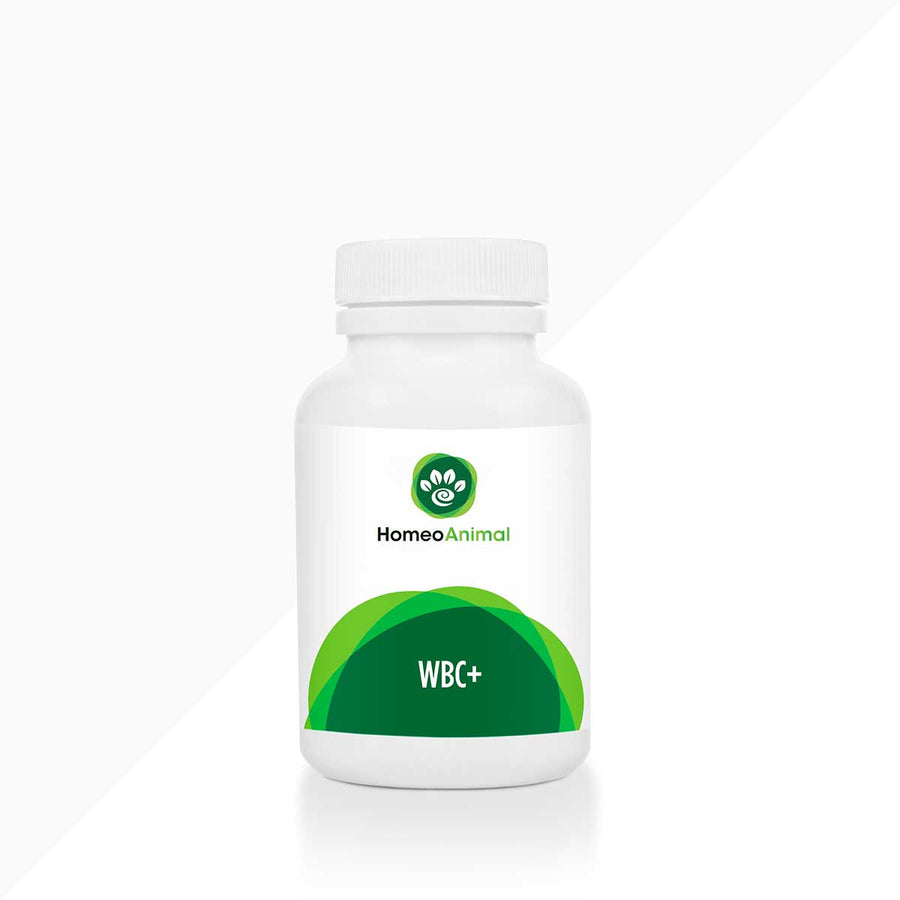Expert-Verified: Top 6 Causes of Low White Blood Cell Count in Dogs
List of Contents
- What Exactly is Leukopenia in Dogs?
- White Blood Cells and Your Dog’s Immune System
- A More Technical Overview of Canine Leukopenia and Neutropenia
- 6 Common Causes of Low White Blood Cell Count in Dogs
- What are the Signs of Low White Blood Cell Count in Dogs?
- How Do Vets Diagnose Low White Blood Cell Count in Dogs?
- What are the Conventional Treatments for Low White Blood Cell Count in Dogs?
- Recovery and Management Tips for Low White Blood Cell Count in Dogs
- The Bottom Line
- FAQS
Learning that your dog has a low white blood cell count can be alarming for any pet owner. White blood cells (WBCs) play a vital role in your dog’s immune system, helping fight infections and other health threats.
An abnormal WBC count may signal an underlying condition that requires prompt veterinary or pet homeopathic attention. This article explains the top causes of low white blood cell count in dogs, helping you understand what to watch for and how to keep your pet healthy.
What Exactly is Leukopenia in Dogs?

Leukopenia is a condition in which a dog has an abnormally low number of circulating white blood cells. Since white blood cells are essential for fighting infection, a low count can indicate an underlying health issue.
Any abnormal WBC result should prompt a veterinary or pet homeopathic evaluation to identify the cause and begin appropriate treatment.
How about neutropenia in dogs?
Neutropenia—low levels of neutrophils, the most common type of white blood cell—is the leading cause of leukopenia in dogs. Because neutrophils play a key role in fighting bacterial infections, dogs with neutropenia are more susceptible to illness.
Prompt diagnosis is essential to identify the underlying cause and begin appropriate treatment.
White Blood Cells and Your Dog’s Immune System
WBCs are vital to your dog’s immune system, helping to detect and fight infections, inflammation, and disease. The five main types of WBCs are neutrophils, eosinophils, basophils, lymphocytes, and monocytes. Each type has a specific role in protecting your dog’s health, and imbalances may indicate an underlying medical condition.
Neutrophils are the most abundant type of white blood cell in dogs and serve as the immune system’s first line of defense. They respond rapidly to bacterial infections and help neutralize foreign invaders. Produced in the bone marrow, neutrophils play a critical role in protecting your dog from illness and infection.
A More Technical Overview of Canine Leukopenia and Neutropenia
As emphasized, leukopenia refers to a condition in which a dog’s total WBC count falls below the normal reference range. In dogs, this range typically spans from 4,000 to 15,500 cells per microliter (μL) of blood.
When WBC levels drop below this threshold, it may indicate a weakened immune response or an underlying health issue requiring veterinary or pet homeopathic attention. Similarly, neutropenia occurs when neutrophil levels drop due to increased destruction, rapid use, or reduced production in the bone marrow.
Since neutrophils are short-lived and essential for combating bacterial infections, a sustained low count can quickly compromise your dog’s immune defenses. This weakened immune response leaves dogs more vulnerable to illness and infection.
6 Common Causes of Low White Blood Cell Count in Dogs

Leukopenia and neutropenia in dogs are not random—they result from specific underlying causes. In this section, we’ll explore the most common reasons behind these conditions and what they mean for your dog’s health.
#1. Severe or chronic infections
Viral infections like Canine Parvovirus, Coronavirus, and Infectious Canine Hepatitis can contribute to low white blood cell counts in dogs. These viruses may suppress bone marrow function or overwhelm the immune system, leading to leukopenia or neutropenia.
Serious bacterial infections, such as sepsis, can cause a low white blood cell count in dogs. Sepsis is a life-threatening condition caused by the body’s dysregulated immune response to harmful microorganisms in the blood or other tissues, often leading to organ dysfunction.
During these infections, WBCs often gather at the infection site, reducing their levels in the bloodstream and weakening the immune response.
Tick-borne parasitic infections like Ehrlichiosis and Anaplasmosis are common causes of low white blood cell count in dogs. These infections or diseases from parasites can impair bone marrow function or destroy white blood cells, weakening the dog’s immune defenses.
Fungal infections can lead to a low white blood cell count in dogs when the immune system is under prolonged stress. As WBCs are quickly used to fight the infection, the bone marrow may struggle to keep up with demand, resulting in leukopenia.
#2.Autoimmune disorders
In some cases, a dog’s immune system mistakenly targets and destroys its white blood cells—a condition known as immune-mediated neutropenia. This autoimmune response can severely lower WBC levels, leaving the dog vulnerable to infections and requiring prompt veterinary or pet homeopathic intervention.
#3. Medications and drug reactions
Certain medications can lead to a low white blood cell count in dogs by suppressing bone marrow function or directly destroying WBCs. Common examples include antibiotics like trimethoprim/sulfamethoxazole, fever reducers such as dipyrone, and thyroid treatments like methimazole.
Chemotherapy drugs, estrogen replacement therapy, and some seizure medications can suppress bone marrow activity, leading to a drop in white blood cell production. These adverse drug reactions may result in neutropenia or, in severe cases, pancytopenia, a deficiency of all blood cell types.
#4. Bone marrow cancer and disorders
Diseases that affect the bone marrow, the site of white blood cell production, can significantly reduce WBC levels in dogs. These include tumors near or within the bone marrow, as well as cancers of the white blood cells themselves, such as leukemia.
Pancytopenia is a serious condition marked by a decrease in all major blood cell types—red blood cells, white blood cells, and platelets. In dogs, it often indicates a significant bone marrow disorder that requires immediate veterinary evaluation. Consulting a pet homeopathy specialist can also help.
#5. Genetic disorders
Certain breed-specific conditions can also cause low white blood cell counts in dogs. Canine Cyclic Neutropenia, or Gray Collie Syndrome, is an inherited disorder marked by dangerously low neutrophil levels every 12 days, often fatal in puppies, while Giant Schnauzers may experience neutropenia due to vitamin B12 deficiency (hypovitaminosis B12).
Additionally, Pelger-Huët Anomaly is an inherited condition in dogs that causes white blood cells to appear abnormal under the microscope. Despite their unusual shape, these cells typically function normally and do not affect the dog’s immune response.
#6. Chronic stress or illness
Stress and corticosteroid use in dogs can lead to a drop in specific white blood cells, particularly lymphocytes and eosinophils, known as lymphopenia and eosinopenia, respectively. While this doesn’t always result in overall leukopenia, it can contribute to reduced immune function and complicate diagnostic results.
In some cases, a mildly low white blood cell count may be normal for an individual dog or reflect a temporary fluctuation. These variations are usually harmless but should still be monitored to rule out underlying issues.
What are the Signs of Low White Blood Cell Count in Dogs?
Dogs with leukopenia or neutropenia often struggle to fight infections, leading to a range of clinical symptoms. Here are the most common ones to watch for:
- Bruising: Easy bruising may occur when platelet levels are also low, potentially pointing to pancytopenia (a reduction in all types of blood cells).
- Lameness: Joint or bone pain can result from infections spreading to other tissues due to a poor immune response.
- Persistent or recurring infections: Frequent infections may signal that your dog’s immune system is compromised and unable to respond effectively.
- Pale gums, mucous membranes, or nose: A pale appearance may suggest anemia or poor circulation, sometimes linked to broader blood cell issues.
- Vomiting: Gastrointestinal upset can be a sign of systemic illness or infection related to low immune cell levels.
- Lethargy or weakness: Reduced energy and activity are common when the body is overwhelmed or chronically ill.
- Diarrhea: Digestive disturbances may reflect inflammation or infection that a weakened immune system can't manage.
- Fever: A high temperature often indicates the body is fighting an infection that it may not be equipped to control.
- Decreased appetite: Dogs fighting infection or inflammation often lose interest in food as part of their overall illness response.
How Do Vets Diagnose Low White Blood Cell Count in Dogs?

If your dog shows indications of a low white blood cell count, seek immediate veterinary attention. A veterinarian will do a complete medical history and physical exam to establish the underlying problem.
A Complete Blood Count (CBC) is the primary diagnostic test for canine leukopenia. This test assesses blood cell counts and types, identifies low levels of specific white blood cells (e.g., neutropenia), and highlights dangerously low counts (less than 2,000 cells/μL) for concern.
After confirming low white blood cell levels, your veterinarian will conduct additional tests to determine the underlying cause. These may include a blood chemistry profile, urinalysis, imaging (such as X-rays or ultrasound), infection screening (e.g., tick-borne diseases), and in complex cases, a bone marrow biopsy.
A thorough diagnostic process also includes evaluating your dog’s breed, age, medication history, vaccination status, and possible exposure to infectious agents. These factors provide critical context that helps your veterinarian identify the most likely cause of a low white blood cell count.
What are the Conventional Treatments for Low White Blood Cell Count in Dogs?
The underlying reason for a dog's low white blood cell count is treated instead of the low count itself. Depending on the diagnosis, treatment may involve supportive care like water and food, immunosuppressive medications for autoimmune illnesses, or antibiotics for infections, always following your veterinarian's advice.
When a low white blood cell count is caused by a bacterial infection, veterinarians typically prescribe antibiotics to target the underlying pathogen. In severe cases like parvovirus, intensive supportive care, including hospitalization, IV fluids, and electrolyte management, is essential to stabilize the dog and support recovery.
For autoimmune conditions causing low white blood cell counts, veterinarians often prescribe immune-suppressing medications like prednisone to reduce the body’s attack on its cells. In cases of cancer, treatment may involve chemotherapy, sometimes alongside prednisone and antibiotics, plus radiation or surgery, typically under the care of a veterinary oncologist.
When leukopenia is drug-induced, treatment usually involves stopping or adjusting the medication responsible. For genetic conditions, management may include treating secondary infections in Gray Collies or supplementing vitamin B12 in Giant Schnauzers, though bone marrow transplants remain a rare and high-risk option.
Unlike anemia, low white blood cell counts in dogs cannot be directly corrected with transfusions or medications to boost WBC levels. Effective treatment depends on identifying and addressing the underlying cause to restore healthy immune function.
But did you know that conventional medication isn’t the only way to support your dog’s low white blood cell count?
How to Naturally Support Your Dog’s Health During Low White Blood Cell Count
Zumalka's WBC+ is a premium natural product designed to support traditional treatments by promoting a healthy white blood cell count and strengthening your dog’s immune system. WBC+ also provides essential minerals like calcium, phosphorus, and magnesium, while supporting joint health and overall vitality.
At Zumalka, our specialists can help you understand the root causes of low WBC and recommend natural, targeted products to support your dog’s immune system and overall vitality. A personalized approach ensures that the symptoms and root causes are addressed as gently and effectively as possible.
Recovery and Management Tips for Low White Blood Cell Count in Dogs
The prognosis and recovery time for dogs with low white blood cell counts depend heavily on the underlying cause. Many cases, such as infections or drug reactions, are treatable and can lead to a full recovery with proper veterinary or pet homeopathic care.
Dogs with severe or chronic low white blood cell counts, such as those caused by hereditary diseases or some types of cancer, may need lifetime care. Depending on how the dog responds to treatment and how healthy they are overall, many illnesses may have a guarded prognosis.
Blood tests and follow-up veterinary visits are crucial for tracking your dog's reaction to treatment and modifying care as necessary. Vaccinations and parasite management are two examples of preventative actions that can help lower the risk of infections that can cause leukopenia.
The cost of detecting and treating leukopenia in dogs can range from $500 to over $8,500, with an average of roughly $2,000, depending on the severity and required therapy. By defraying these costs, pet insurance can assist you in managing your dog's care more economically.
Proper nutrition from high-quality dog food is essential for overall health, especially during recovery from a low white blood cell count. Always follow your veterinarian’s dietary recommendations to ensure your dog receives the nutrients needed for immune function and healing.
Consulting a qualified pet homeopath may offer natural support options and help minimize the risk of adverse reactions to conventional medications. This holistic approach can complement your veterinarian’s treatment plan for more personalized care.
The Bottom Line
Dogs with low white blood cell counts should promptly see a veterinarian because this is a major health issue. A comprehensive, successful care plan for your dog's recuperation and long-term health can be developed in collaboration with your veterinarian and, where necessary, a certified pet homeopathy specialist.
Finding the reason for your dog's low white blood cell count and developing a customized treatment plan are critical tasks for your veterinarian. A trained specialist in pet homeopathy can also provide advice on safe, all-natural ways to support veterinarian care.
The key to effectively treating many causes of low white blood cell counts in dogs is early discovery and appropriate veterinary care. Your dog's chances of making a full and healthy recovery are significantly increased with prompt treatment and, when necessary, supporting advice from a pet homeopathy expert.
FAQS
Can a dog survive with a low white blood cell count?
Yes, a dog can survive with a low white blood cell count, especially if the underlying cause is identified early and treated promptly with proper veterinary care, supportive therapies, and ongoing monitoring. Consulting a pet homeopathy expert can also help.
How can I increase my dog's white blood cell count?
To increase your dog’s white blood cell count, follow your veterinarian’s treatment plan, which may include addressing underlying conditions, providing proper nutrition, and considering supportive therapies like supplements or natural immune-boosting options. Using natural options like WBC+ is also beneficial.
What are the most common reasons for a low white blood cell count?
The most common reasons for low white blood cell count in dogs include infections, autoimmune diseases, bone marrow disorders, medication side effects, cancer, and genetic conditions—all of which require prompt veterinary evaluation and care. A qualified pet homeopath can also help.
What do white blood cells mean in a dog?
Dogs' white blood cells are vital parts of their immune systems, aiding in the battle against illness, inflammation, and infections. Unusual levels could point to a medical condition that has to be treated by a veterinarian or pet homeopath.
What causes low red and white blood cells in dogs?
Low red and white blood cells in dogs can result from infections, autoimmune diseases, bone marrow disorders, certain medications, toxins, or cancer. These conditions affect blood cell production or survival and require prompt veterinary or pet homeopathic diagnosis and treatment.
How do I tell if my dog is anemic?
Pale gums, weakness, drowsiness, fast breathing, and decreased appetite are all symptoms of anemia in dogs. For a diagnosis and suitable therapy, see your veterinarian or pet homeopathic specialist as soon as you observe these symptoms.
What is distemper in dogs?
Dogs can contract distemper, a highly contagious viral illness that affects the neurological, gastrointestinal, and respiratory systems. Without early immunization, diagnosis, and supportive veterinarian care, it can be fatal and spread by airborne exposure.
What are the symptoms of leukemia in dogs?
Symptoms of leukemia in dogs may include lethargy, weight loss, pale gums, recurring infections, enlarged lymph nodes, and bleeding issues. These signs develop gradually and require prompt veterinary evaluation for accurate diagnosis and treatment. Consulting a pet homeopathy specialist can also help.









Hi Marie, Thanks for reaching out to us about your dog! I’ve sent you an email to get some more information from you in order to help him best.
My small 13 month dog had a liver shunt surgery and bladder stone removal now his white blood cells are very hight
Hi Tammy, We have reached out to you by email to get some personalized help for your dog from our Homeopath. Please respond to the questions in the email so we can help you better.
my dog needs her red and white blood cells rised and her blood sugar but she will not eat or drink i been watering her and feed ing by a syring
Hi Denise,
I’m sorry to hear that your dog is not feeling well! Please answer the questions in the email we sent you to receive some personalized help from our Homeopath.
Leave a comment